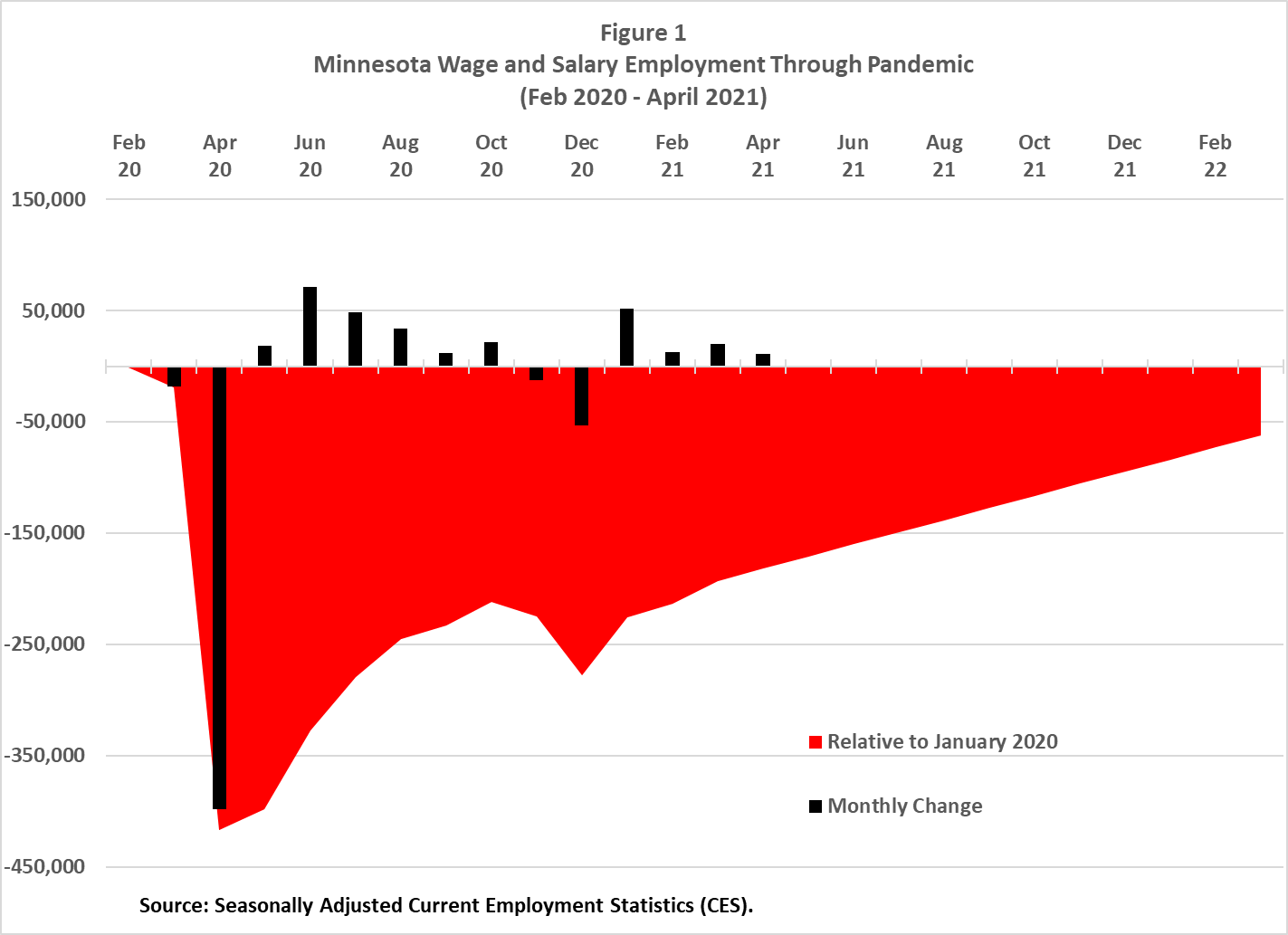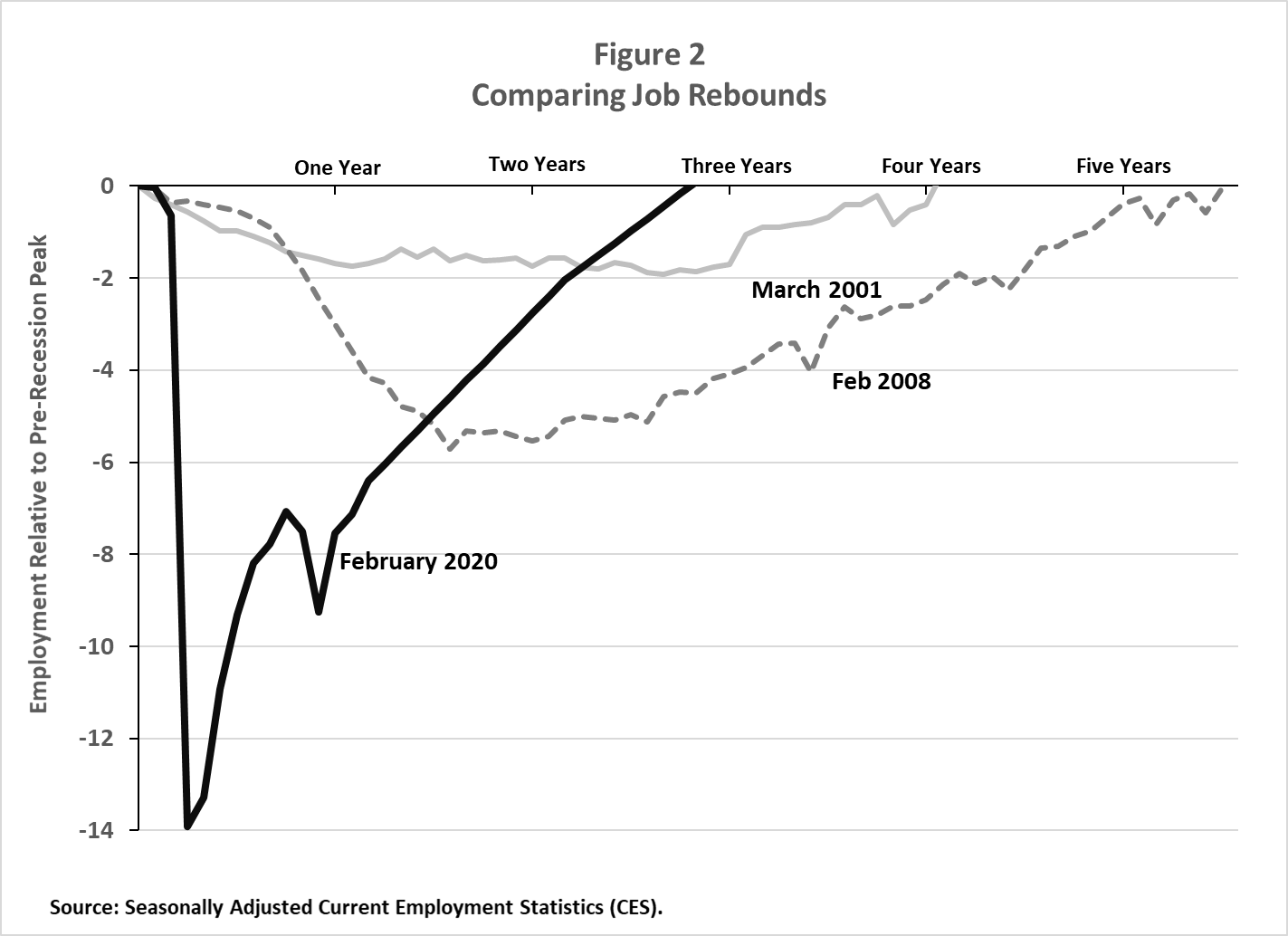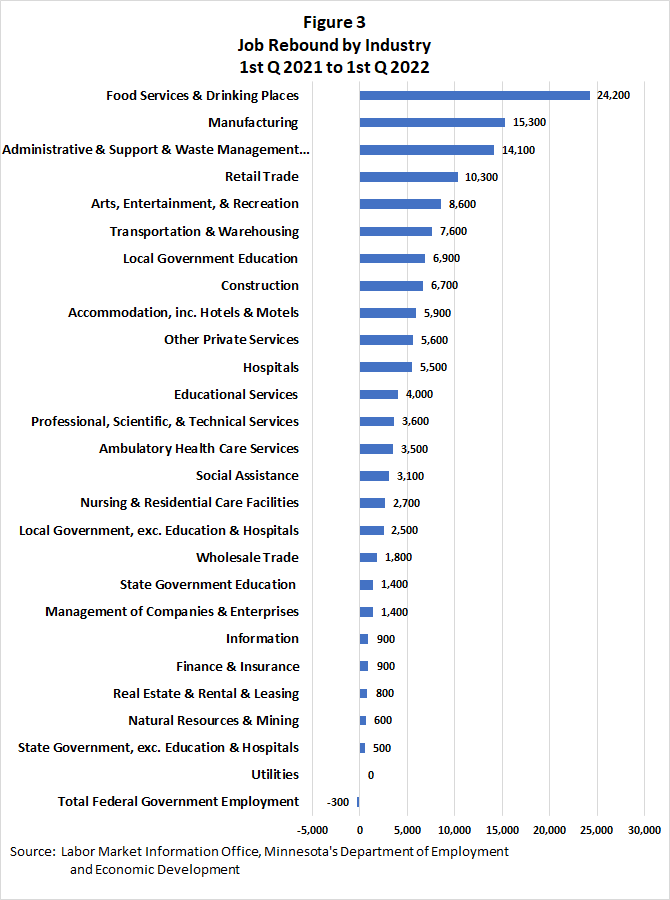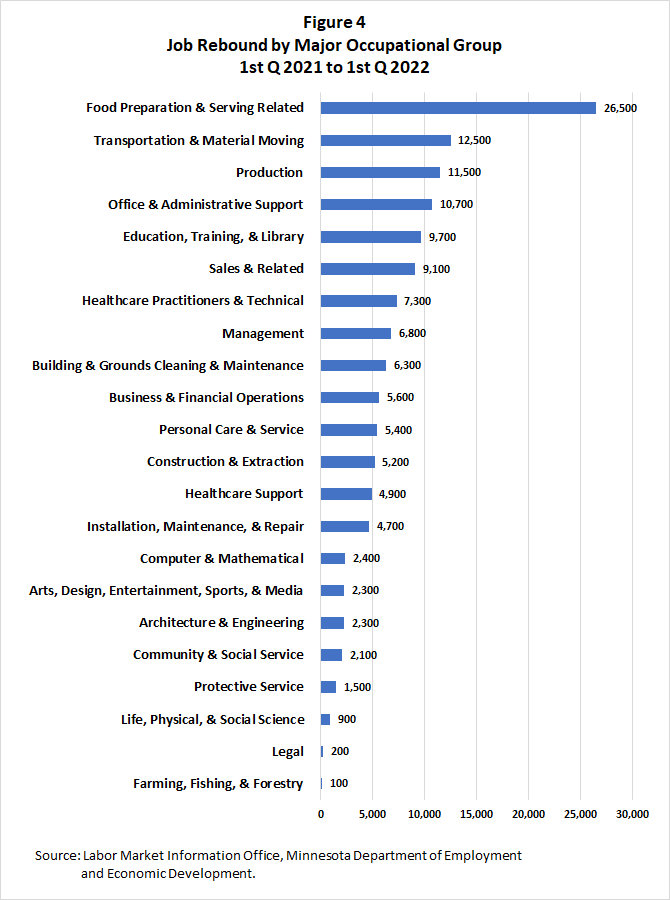
by Dave Senf
June 2021
The Minnesota Department of Employment and Economic Development's (DEED's) Labor Market Information (LMI) office has published one-year employment forecasts quarterly since 2009. This forecast projects job growth in Minnesota between the first quarter of 2021 and the first quarter of 2022.
It is important to note that job forecasts are based on numerous factors, which can change unexpectedly and alter the employment growth outcomes in ways that are unpredictable. This has never been more true than during the pandemic, which has presented factors economists typically don't need to take into account including vaccination rates, vaccine effectiveness against new virus strains and the contagiousness and relative dangerousness of new variants.
Prior to the pandemic the one-year employment forecasts were based primarily on statistical models. For more recent forecast rounds LMI analysts relied more heavily on information from IHS Markit, the economic consulting firm used by Minnesota Management and Budget in their budgeting work, because the extreme employment swings in many sectors made some statistical models unreliable. Most employment data at the sector level has returned to more normal patterns over the last six months allowing LMI analysts to return to their pre-pandemic forecast methods for all but a few industries.
It is also important to understand that these employment projections assume the labor force bounces back to meet the job growth forecasted. There are indications that the constraints on job growth are more on the supply side than the demand side for some industries at this point in the rebound. That said, Minnesota is projected to have the strongest job growth in 30 years between the first quarter of 2021 and the first quarter of 2022.
Minnesota's job recovery from the pandemic accelerated during the first quarter of 2021 and is expected to remain strong throughout 2021 as COVID-19 cases continue to decline and hiring ramps up. As the past year has shown, Minnesota's short-term job growth has been dependent on the trajectory of COVID-19 cases in the state. With 65% of Minnesotans 16 and over vaccinated as of early June, job growth appears to be here to stay for the foreseeable future. The state has added 95,700 non-farm wage and salary jobs since the beginning of the year and as of April, has recovered 235,300 jobs, roughly 56%, of the 416,000 jobs lost between February and April of 2020 (see Figure 1).

U.S. GDP growth is on track to exceed 6% in 2021, the highest rate since 1984. The expected robust U.S. recovery will come with plenty of bumps as the vaccine-induced reopening of the economy faces numerous supply chain bottlenecks, such as the ongoing shortage of computer chips for auto producers, as well as temporary labor shortages. However, the recovery will push through supply constraints as solid growth in business equipment investment, residential construction, and government spending fuel the expansion. High savings, pent-up household demand, and increasing wage and salary income from expanding employment will support healthy consumer spending throughout the year.
Forecasted job growth between the first quarter of 2021 and the first quarter of 2022 will lift Minnesota's employment base to roughly 98% of the pre-pandemic level. By March 2022, employment should be only about 61,000 jobs below the February 2020 level, meaning that roughly 85% of jobs lost during the pandemic recession will have been recovered. Of course, not all industries are expected to recover fully, but job growth in other industries beyond pre-pandemic levels will eventually push Minnesota's employment base past its January 2020 peak by late 2022 or early 2023.
If forecasted job growth proves right, the peak-to-bottom-to-peak path of the pandemic recession will be just short of three years. That is a relatively quick rebound, at least in comparison to past recessions. Complete job recovery in Minnesota from the Great Recession stretched out to more than five years, while the 2001 recession required four years for jobs to get back to pre-recession level (see Figure 2). The steep job loss last year, however, was much deeper than during previous recessions, so the job market pain will be roughly equivalent to the Great Recession pain after taking into account the duration and depth of the job loss over the two job recovery periods.

Initial claims for Unemployment Insurance (UI) were the first indication of how steep job loss would be last April. The good news on the initial claims front is that numbers have steadily decreased, with recent weekly readings only 1.5 times higher than pre-pandemic levels rather than 30 times higher last April and 7 times higher last December. Regular and PUA continuing claims for unemployment benefits have also trended favorably, declining to 228,581 in April compared to the peak of 559,023 in April 2020.
Minnesota's short-term jobs forecast for the one year period from the 1st quarter of 2021 to the 1st quarter of 2022 predicts that the state will add 138,000 jobs, expanding by 5.0% over the year. The forecasted job expansion averages out to 11,500 jobs a month, compared to the 20,000 job gain averaged over the last 12 months. The 5.0% forecasted job growth pace would be the fastest since 1984, when annual job growth reached 5.9%. The robust job growth in 1984 followed on the heels of the double-dip recessions during the first few years in the 1980s. Likewise, the 5.0% forecasted job growth in 2021 follows on the heels of the pandemic-induced, short-but-steep recession last year.
According to projections, job growth will be widespread but will still be stronger in industries that were hit the hardest by the pandemic (see Figure 3). Because they dropped more, they have more to gain back. Industries expected to add the most jobs over the next 12 months are:

Some of these industries involve face-to-face interaction with customers and were the most disrupted by the pandemic. These industries will bounce back robustly as the state turns the corner in its battle with the virus and spending on dining out, travel, tourism, recreation, sporting events and live arts performances picks up. Employment in most direct consumer-facing industries however will still be in the 85 to 90% range of pre-pandemic payroll numbers through the first quarter of 2022.
Manufacturing has recovered roughly 8,000 of the 22,000 jobs lost last year when the pandemic set in. Job growth at Minnesota manufacturers over the next 12 months is expected to be very strong as the state's manufacturers sharply increase production to meet rising demand. Manufacturing employment is expected to be back to its pre-pandemic level by early next year.
Administrative and Support Services lost 25,000 jobs during the early months of the pandemic and has added roughly 15,000 jobs since. Job growth in this industry, especially at Employment Services companies and Services to Building and Dwellings firms, should push this industry's employment base above its pre-pandemic total in 2022.
Food Preparation and Serving Related occupations (i.e. fast food and counter workers, waiters and waitresses, and restaurant cooks) are forecast to add the most jobs over the next 12 months as dining places and drinking establishments reopen to full capacity (see Figure 4).

Hiring for Transportation and Material Moving jobs, such as laborers and freight, stock, and material movers, heavy and tractor-trailer truck drivers, light truck or delivery services drivers, and stockers and order fillers, is expected to climb sharply, pushing this major occupational group to second on the list of occupational groups adding the most jobs over the next 12 months.
The anticipated bounce back in Minnesota's manufacturing sector will boost demand for workers in many production occupations, including miscellaneous assemblers and fabricators, machinists, welders, cutters, and production helpers. Many of the projected jobs being added are also in skilled production occupations that manufacturers have been having a hard time filling even before the pandemic.
Forty-one percent (315 occupations) of the 773 occupations covered in the short-term job forecast will grow faster than the predicted 5% overall job growth rate. Twenty-nine percent (222 occupations) are projected to increase between 3% and 5%, while 27% (209 occupations) are expected to experience gains below 3%. Only 3% of occupations are expected to shrink over the next year.
Job growth is expected to greatest in industries and occupations with a higher share of workers who are Black, Indigenous and People of Color (BIPOC). Unfortunately even with those expected strong job gains over the next 12 months, the job recovery in Minnesota's BIPOC communities will still trail the overall job recovery, since a large share of the 61,000 jobs predicted not to come back by mid-2022 are in industries and occupations disproportionally staffed by BIPOC workers.1
The robust and widespread job rebound expected across industries and occupations over the next year will benefit all job seekers. During the pandemic recovery, factors could emerge that alter jobs forecasts. It is possible that new developments related to COVID-19 or lack of growth in the labor force could hold Minnesota back from more rapid job growth in the coming months. DEED's labor market analysts revise these annual forecasts every three months to adjust for changes in labor market trends, while DEED's workforce and economic development staff will continue to work with unemployed Minnesotans and Minnesota employers to connect people with jobs.
1Detailed industry and occupational forecast are available at Employment Outlook.